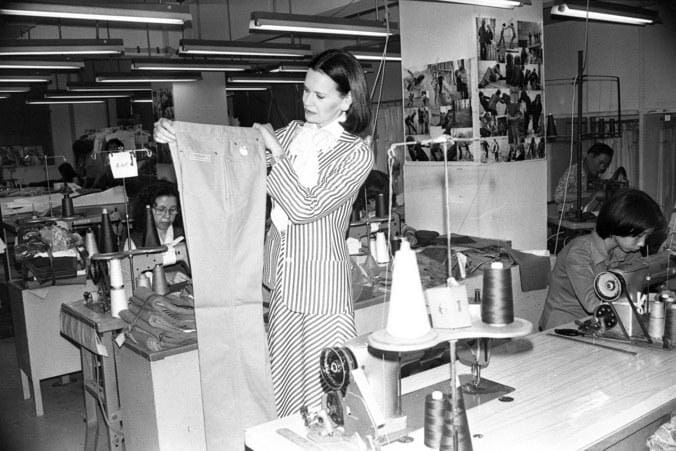Gloria Vanderbilt arrived on the fashion scene at a time when the only jeans available to women were denims that had been constructed for cowboys and styled for 1800s coal miners. The jeans fit B.G. (Before Gloria) was fine for 10-year-olds, but tragic for girls who had developed even a little bit of a woman’s body. Jeans were styled so that waistbands riding low on the hips bisected the tummy in unflattering fashion. Denims sized large enough for the derriere assumed a waist big enough to match one’s rear end. Females who tried to squeeze into the unforgiving cut suffered humiliating frustration. Jeans of the early ‘70s simply did not accommodate women.
Gloria delivered her perfect fit jeans that recognized and celebrated a woman’s curves. No wonder those jeans became an instant hit and remain so to this day.
Gloria had her own dress designing business on Seventh Avenue when fellow businessman Mohan Murjani asked her to design blouses for his company. There she met Murjani’s marketing genius, Warren Hersch, who told her about the company’s stash of denim fabric stored in Hong Kong. “Why don’t we make jeans, a really great fit jean?” Vanderbilt suggested.
Their collaboration gave birth to the iconic jeans branded with Vanderbilt’s signature sewn on the back right pocket and a small gold swan embroidered on the front.
The daughter of railroad heir Reginald Vanderbilt, Gloria was famous before she was in her teens. A bitter custody battle between her mother and her later father’s sister created a Depression-era scandal and cast little Gloria into the eye of a traumatizing public storm. She married the first of her four husbands at the age of 17 and inherited $4.5 million when she turned 21.
Since her death at age 95 in June, much of the celebration of Gloria’s life has focused on the role she played as the first American to exploit a famous family name on designer clothing. Diane von Furstenberg may have been the first society figure to put her name on a clothing brand. But Gloria Vanderbilt was the woman who married the status of authentic old money to America’s most democratic wardrobe staple. Some credit Gloria as the creator of designer jeans.
The line was introduced with a $1 million television commercial that featured Gloria letting women know her pants were designed to “really hug your derrière.” All 150,000 pairs of jeans that Murjani’s company had produced sold out the day that commercial was shown.
“The marketing of Gloria Vanderbilt jeans is one of the most dramatic American business success stories of the decade,” The New York Times reported in 1979. “The key to its success was the marriage of a great name, Vanderbilt, to jeans, which began as the uniform of student demonstrators of the ’60s and developed into the fashion phenomenon of the ’70s.”
That same year Gloria’s jeans were America’s best sellers. The line beat rivals Calvin Klein, Jordache and Sasson. She earned more than $17 million from 1978 to 1984 and sold the rights to her name long before the Jones Apparel Group bought Gloria’s fashion empire for $100 million in 2002.
She helped pave the way for today’s style setters who sell their own glamour as clothing brands. She was a master marketer, but it wasn’t only the Vanderbilt name that Gloria was selling. She was more than just a purveyor of branding. The magic that Gloria sold was something that had been sorely missing, and that was fit that flatters a woman. Women who wore Gloria’s jeans then and who wear them today still prize how they make us feel beautiful.






